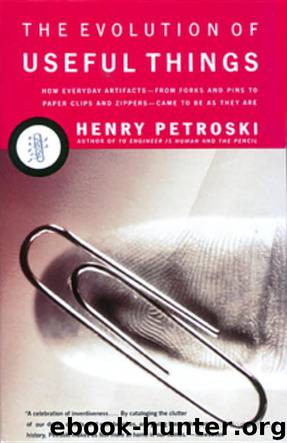The Evolution of Useful Things: How Everyday Artifacts-From Forks and Pins to Paper Clips and Zippers-Came to Be as They Are. by Henry Petroski

Author:Henry Petroski [Petroski, Henry]
Language: eng
Format: epub, mobi
ISBN: 9780307773050
Google: QfZ1bVoPI9EC
Amazon: B004CFAW6G
Publisher: Vintage Books
Published: 1992-12-01T08:00:00+00:00
The form of serving pieces intended for the same purpose could also vary widely from manufacturer to manufacturer, as illustrated here. Top row, left to right: sardine forks (three styles), sardine fork and helper, and jelly knives (five styles). Middle row: tomato servers (three styles) and tomato fork. Lower left: butter knives (four styles). Lower right, top to bottom: cheese servers (two styles), cheese knife, and cheese scoops (four styles). (photo credit 8.4)
What Emily Post and more recent etiquette writers advise is that a few basic pieces of flat silver are sufficient to set even the best of tables. These essential pieces are: “table spoon, dessert spoon, tea spoon, after dinner coffee spoon, …, large fork—often called a dinner fork, small fork—sometimes called salad or dessert fork, …, large knife—dinner knife with steel blade, small knife—silver blade, …” The ellipses represent specialized spoons, forks, and knives that are included in “the most complete list of flat silver possible in a perfectly equipped home” but that “may be subtracted as unnecessary.” But illuminating the origins of the “unnecessary” pieces, which were once no doubt argued by someone to be “necessary,” provides valuable insights into the evolution of some familiar if puzzling artifacts.
Much modern silver is very attractive to look at and very comfortable to hold. However, in the course of eating in restaurants and at dinner parties, it is not uncommon to find certain features of a particular place setting that can easily be judged wanting. For example, whereas most dinner forks are generally comfortably large, with four reasonably sharp tines spread over a good width, some forks with obvious pretensions toward modernity have three widely spaced and bluntly shaped tines that are as effective as stumps for eating food. Sometimes, even when a silver pattern’s dinner fork is seemingly perfectly proportioned, other forks in the same set can have rather short and stubby tines that make it difficult to spear and to hold securely a piece of lettuce—or anything else, for that matter. Furthermore, with some forks the small surface of the tines, which converge to a shape more like that of a teaspoon than a fork, can offer very little support area and less of a cradle for the food than we might like. As attractive as such forks might be to look at, I have always felt that their business end is not suited to comfortable eating. In short, they seem to be somewhat of a functional failure as forks, yet households and restaurants become committed to them.
Sterling silver is generally a one-time investment, and aesthetics seems very often to play a more important role than function in the initial selection and, often, willy-nilly lifetime commitment to the pattern. Silverplate, on the other hand, is not expected to last indefinitely. Around the turn of the century, better silverplate was sold with the understanding that its plating might be good for twenty-five years with proper care, and it was expected that replating would be done as required. On such
Download
The Evolution of Useful Things: How Everyday Artifacts-From Forks and Pins to Paper Clips and Zippers-Came to Be as They Are. by Henry Petroski.mobi
This site does not store any files on its server. We only index and link to content provided by other sites. Please contact the content providers to delete copyright contents if any and email us, we'll remove relevant links or contents immediately.
Hands-On Genetic Algorithms with Python by Eyal Wirsansky (2020) by Unknown(4052)
Thing Explainer by Randall Munroe(3875)
The Elements by Theodore Gray(2995)
The Meaning of it All by Richard Feynman(2298)
Make by Mike Westerfield(2287)
Every Tool's a Hammer by Adam Savage(1887)
Science Experiments You Can Eat by Vicki Cobb(1838)
The Perfectionists by Sara Shepard(1781)
Martin Gardner's Science Magic by Martin Gardner(1685)
Raspberry Pi Electronics Projects for the Evil Genius (Tab) by Norris Donald & Norris Donald(1673)
Elephants on Acid by Boese Alex(1565)
Elephants on Acid: And Other Bizarre Experiments by Alex Boese(1563)
The Perfectionists by Simon Winchester(1555)
Handbook of Modern Sensors by Jacob Fraden(1542)
Synchrotron Light Sources and Free-Electron Lasers by Eberhard J. Jaeschke Shaukat Khan Jochen R. Schneider & Jerome B. Hastings(1522)
Tesla by Carlson W. Bernard(1484)
The Science of Food by Marty Jopson(1447)
The Meaning Of It All by Richard P. Feynman(1420)
125 Physics Projects for the Evil Genius by Silver Jerry(1416)
